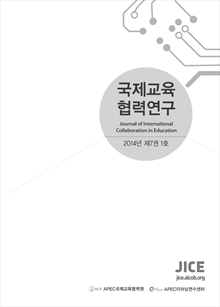간행물
국제교육협력연구지 Journal of International Collaboration in Education

- 발행기관 APEC국제교육협력원
- 자료유형 학술지
- 간기 반년간
- ISSN 2005-1190 (Print)2288-6389 (Online)
- 수록기간 2008 ~ 2014
- 주제분류 사회과학 > 교육학 사회과학 분류의 다른 간행물
- 십진분류KDC 371DDC 379
권호리스트/논문검색
제2권 제1호 (2009년 7월) 4건
1.
2009.07
구독 인증기관 무료, 개인회원 유료
본 연구의 목적은 World Bank에서 실시된 교육정보화분야의 사업들을 한국교육정보화 연대기를 통해 분석하여, 현재 World Bank가 추구하는 교육정보화 사업의 방향과 핵심내용을 파악하는데 있다.본 연구의 방법은 문헌연구와 선행연구를 분석한 후, World Bank시행된 교육정보화에 사업중 한국정보문화진흥원에서 발표한 연구에 제시된 우선 협력 국 기준에 따라 7개국을 선정하였다. 또한 본 연구의 분석준거를 마련하기 위해, 한국의 교육정보화에 대한 연구도 병행하였다. 연구의 절차는 한국의 교육정보화에 대한 연구를 통해 분석 대상 국가들에서 실시된 교육정보화사업이 한국의 교육정보화 단계에 비추어 어느 정도 수준인지를 제시하고, 이를 분석 대상국의 1인당 GNI, DOI를 바탕으로 비교․분석 하였다. 이를 통해서 분석 대상국들의 교육정보화 사업의수준이 경제적 수준과 정보화 수준에 따라 어떠한 분포를 보이는지 파악할 수 있다.본 연구를 통해 다음과 같은 결론을 도출하였다. 첫째, World Bank의 교육정보화 사업은 한국의 교육정보화 단계 중 도약기 수준에서 실시되고 있다. 둘째, World Bank의 교육정보화 사업은수혜국의 DOI 수준에 고려하여 계획 및 설계될 필요가 있다.
5,700원
2.
2009.07
구독 인증기관 무료, 개인회원 유료
Development of Problem-Based Learning Problem Design Model in Middle School Home Economics Education
본 연구는 가정과 교사들이 쉽게 PBL 문제를 개발할 수 있도록 PBL 문제개발 모형을 제안하는 것을 목적으로 한다. 이러한 연구목적을 달성하기 위해 문헌연구와 선행연구 분석을 통해 중학교 가정과 PBL 문제개발에 필요한 절차 및 요소를 도출한 후 모형 초안을 개발하였고, 전문가검토 및 수정을 거쳐 모형을 완성하였다. 이를 토대로 중학교 1학년 교과의 한 단원에 적용하였다. 본 연구에서 제안하는 PBL 문제개발 절차는 가정교과에서 무엇을 학습할 것인가를 파악하는‘교육과정 분석하기’, 학생들의 특성과 요구조사 및 알고 있는 것과 알고 싶은 것을 확인하는 ‘학생관심 및 수준 분석하기’, 관련 자료를 찾는 ‘자료검색 및 수집하기’, 상황설정, 배경, 주인공의역할 및 과제 등을 제시하여 문제를 완성하는 ‘문제 작성하기’, 작성된 문제가 교육과정 및 구성주의 원리에 맞는 좋은 문제인지를 검토하는 ‘타당성 검토하기’의 순으로 이루어진다. 본 모형은가정과 교사들에게 PBL 문제작성에 절차적인 지침을 제공하여 가정과 PBL 문제개발을 용이하게 할 것이다.
5,200원
3.
2009.07
구독 인증기관 무료, 개인회원 유료
This is a study done to assess the level of Informatization, simple definition of utilization of Information and Communication Technologies (ICTs), in the rural areas of Sri Lanka. The level of Informatization is measured as an index value. In the Asia Pacific region different types of Informatization Indices are calculated in different countries. In this study authors have defined a mechanism to calculate the Informatization Index for Sri Lanka, by considering the number of indices related to Informatization. This Informatization Index is calculated using 48 measures categorized under 11 sub components of ICT. Also a hypotheses testing based on an identified analysis framework is conducted in this study. According to the results obtained from this study, it was observed that in rural areas high utilization is there for utilization of Radio, Television, and Telephone. Mobile phone and Computer utilization is at a medium level. Level of utilization of ICT also varies with the demographic factors also.
4,500원
4.
2009.07
구독 인증기관 무료, 개인회원 유료
This study focuses itself on designing a guide for workplace self-directed lifelong learning and assessment in distance learning. The areas the guide is designed on are: ①diagnosing learners’ needs, ②formulating self-learning goals, ③identifying human and material resources, ④selecting and implementing appropriate SDL strategies and ⑤evaluating own performance. The five instruments comprise a comprehensive qualification framework where each of the five is placed under the circular relationship nexus so that upward and downward interplay among each element works functionally. Task of designing a guide for workplace self-directed lifelong learning and assessment in distance learning is suggested to be a 21c challenge each nation faces in knowledge-based digital and globalization era.
6,100원

